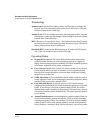
Port Status and Basic Configuration
QoS Pass-Through Mode on the Series 2800 Switches
cant performance improvement for high-bandwidth traffic flows through the
2800 switches, particularly when running traffic flows from 1000Base to either
100Base or 10Base connections.
QoS Pass-Through mode is OFF by default, and must be enabled via the
“config” context of the CLI by entering the CLI command qos-passthrough-
mode, followed by write memory and rebooting the switch.
QoS Pass-Through mode, when enabled, results in the following general
changes to switch operation:
■ Alters the switch's default outbound priority queue scheme from four
queues (low, normal, medium, and high), to two queues (normal &
high).
■ Optimizes outbound port buffers for a two-queue scheme.
■ All packets received with an 802.1p priority tag of 0 to 5 (low, normal,
or medium priorities), or tagged by the switch's QOS feature, will be
serviced by the (now larger) "normal" priority queue.
■ All packets received with an 802.1p priority tag of 6 or 7 (high priority),
or tagged by the switch's QoS feature, will be serviced by the "high"
priority queue.
■ High priority packets sourced by the switch itself, such as Spanning
Tree packets, will be serviced in the "high" priority queue.
■ Any 802.1p tagging on a received packet, or any tag added to a
received frame by the switch via its QoS configuration, will be
preserved as it is transmitted from the switch.
NOTE: As stated earlier, use of this QoS-Passthrough-Mode feature
generally assumes that QoS tagged packets are not being sent through
the 2800 Switch. The receipt of priority 6 or 7 packets may in fact
suffer packet drops depending on the traffic load of non-priority 6 or
7 packets.
QoS Priority Mapping With and Without QoS Pass-Through Mode
The switch supports 802.1p VLAN tagging, which is used in conjunction with
the outbound port
priority queues to prioritize outbound traffic.
10-26


















